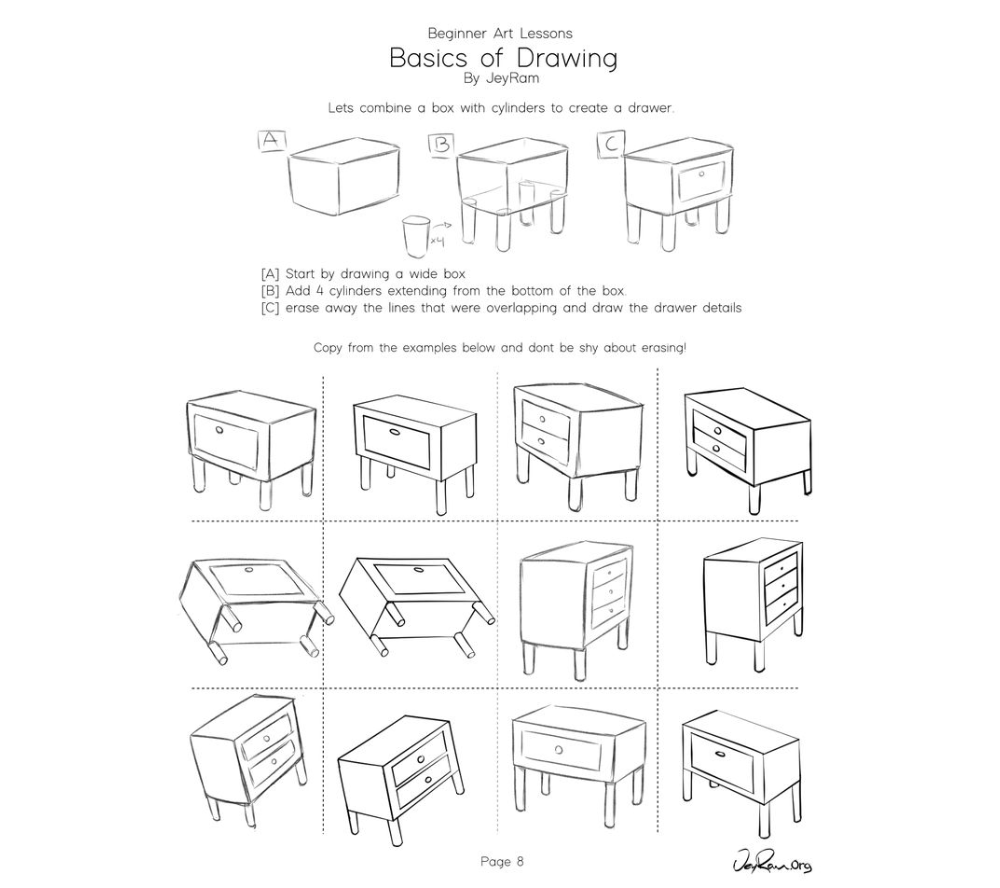Beginner Art Lessons – Basics of Drawing Description

The image titled “Beginner Art Lessons – Basics of Drawing” by JeYRam serves as an educational guide for aspiring artists, focusing on the foundational techniques of drawing a dresser by combining basic shapes. Presented on “Page 8” with a signature from JeYRam.org, this instructional page is designed to encourage beginners to practice and develop their skills through step-by-step guidance and example drawings. The layout is clean and structured, featuring a three-step process diagram at the top and a grid of example drawings below, making it an accessible resource for learning art basics.
Step-by-Step Process
The top section outlines a three-step method to create a dresser drawing, illustrated with simple line sketches labeled A, B, and C:
- [A] Start by drawing a wide box: The first sketch shows a basic rectangular box, representing the main body of the dresser. This establishes the foundational shape and proportions.
- [B] Add 4 cylinders extending from the bottom of the box: The second sketch builds on the box by adding four cylindrical legs, introducing depth and structure to simulate the dresser’s support.
- [C] Erase away the lines that were overlapping and draw the drawer details: The final sketch refines the drawing by removing overlapping lines and adding details like drawer fronts and knobs, resulting in a completed dresser design.
The accompanying text, “Lets combine a box with cylinders to create a drawer,” encourages learners to follow this process, while the note “Copy from the examples below and dont be shy about erasing!” fosters a hands-on, experimental approach to drawing.
Example Drawings
Below the instructions, a 3×3 grid presents nine example dresser drawings, each showcasing variations in perspective, proportion, and detail. These examples demonstrate the flexibility of the technique and inspire creativity:
- The top row includes three drawings with slight variations in leg placement and drawer design, offering a standard upright perspective.
- The middle row features three drawings with more dynamic angles, including a tilted view and a dresser with multiple drawers, highlighting different viewpoints and complexity.
- The bottom row shows three additional variations, with one featuring two drawers and another emphasizing a minimalist design, encouraging learners to explore different styles.
Each drawing is outlined in black ink with dashed lines separating the grid cells, providing a clear visual guide for replication. The simplicity of the sketches, combined with their diversity, helps beginners practice observing and adapting shapes.
Connection to Previous Guides
This art lesson diverges from the practical, tool-based guides on “12 Essential Woodworking Tools For Beginners,” “Types of Measuring Tools,” “Welding Tools,” and the scientific focus of the “Pterosaur Fossil” post. However, it shares a thematic link through the concept of craftsmanship. Just as woodworking, measuring, and welding require precision and skill, drawing demands an understanding of proportion and structure—skills that can be applied across these disciplines. For instance, the use of a “try square” from the measuring tools guide or a steady hand honed by welding could enhance an artist’s ability to draw accurate angles and shapes. The dresser, a common woodworking project, also ties this lesson back to the woodworking tools post, bridging art and construction.
Educational Value
Created by JeYRam, this lesson is part of a broader series aimed at building foundational drawing skills. The emphasis on combining geometric shapes (boxes and cylinders) introduces beginners to perspective and three-dimensional rendering, key concepts in art. The encouragement to erase and refine aligns with the iterative process seen in crafting and scientific illustration, such as the detailed labeling in the pterosaur fossil image. This page, captured as of 06:50 PM EDT on Tuesday, June 03, 2025, is an excellent starting point for anyone looking to explore drawing and develop their artistic confidence.
This guide not only teaches the mechanics of drawing a dresser but also inspires creativity, making it a valuable addition to your website’s collection of skill-building resources.
